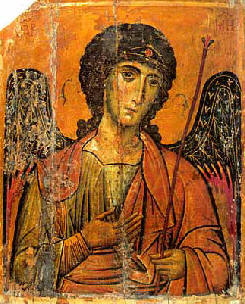米歇尔节

Table of contents
米迦勒节,或米迦勒和所有天使的节日,在每年的9月29日庆祝。 由于这一天接近春分,所以与秋天的开始和白昼的缩短有关;在英国,它是 "四分之一日 "之一。
传统上一年有四个 "季度日"(淑女节(3月25日)、仲夏节(6月24日)、米迦勒节(9月29日)和圣诞节(12月25日))。 它们相隔三个月,在宗教节日,通常接近至点或分点。 它们是雇用仆人、租金到期或开始租赁的四个日期。 过去,人们说收获必须完成米迦勒节是生产季节的结束和新一轮农业生产的开始,是雇用新仆人或交换土地和偿还债务的时间。 这就是米迦勒节成为选举地方官员的时间,也是法律和大学学期开始的原因。
 圣米迦勒是主要的天使战士之一,是对抗黑夜的保护者,也是对抗撒旦及其邪恶天使的大天使。 由于米迦勒节是更黑暗的夜晚和更寒冷的日子开始的时候--进入冬季的边缘--米迦勒节的庆祝活动与鼓励在这些黑暗的月份里提供保护有关。 人们相信,负面力量是在黑暗中更加强大,因此家庭在一年中的晚些时候需要更强的防御能力。
圣米迦勒是主要的天使战士之一,是对抗黑夜的保护者,也是对抗撒旦及其邪恶天使的大天使。 由于米迦勒节是更黑暗的夜晚和更寒冷的日子开始的时候--进入冬季的边缘--米迦勒节的庆祝活动与鼓励在这些黑暗的月份里提供保护有关。 人们相信,负面力量是在黑暗中更加强大,因此家庭在一年中的晚些时候需要更强的防御能力。
传统上,在不列颠群岛,收获后用田里的麦茬喂养的肥鹅被吃掉,以保护家庭来年的经济需求;正如谚语所说:
"在米迦勒节吃一只鹅、
一年到头不为钱而想"。
有时这一天也被称为 "鹅日",并举行鹅市。 即使现在,著名的诺丁汉鹅市仍在10月3日或前后举行。 吃鹅的部分原因是,据说当伊丽莎白一世女王听说无敌舰队被打败时,她正在吃鹅,并决心在迈克尔斯日吃鹅。 其他人也效仿。 它也可能发展为通过米迦勒节的作用,因为债务到期了;要求延迟付款的租户可能试图用鹅的礼物来说服他们的房东!
在苏格兰,还创造了圣迈克尔班诺克(St Michael's Bannock)或斯特鲁恩-米歇尔(Struan Micheil)(一种大的司康饼)。 这曾经是用一年中在家庭土地上种植的谷物制成的,代表田地的果实,并在羊皮上烹制,代表羊群的果实。 谷物还用羊奶滋润,因为羊被视为最神圣的动物。 因为斯特鲁恩是由该家族的长女创建的,如下所述:
"后代和家庭的繁荣,迈克尔的神秘,三位一体的保护"
See_also: 电缆街之战通过这样的庆祝方式,家庭的繁荣和财富在来年得到了支持。 当亨利八世与天主教会分裂时,庆祝迈克尔马斯日作为收获的最后一天的习俗被打破;相反,现在庆祝的是丰收节。
在英国民间传说中,10月10日的老米迦勒节是采摘黑莓的最后一天。 据说在这一天,当路西法被逐出天堂时,他从天而降,直落到黑莓丛中。 然后他诅咒水果,用他炽热的气息烧焦它们,在它们身上吐口水和踩脚印,使它们不适合食用!于是爱尔兰谚语说:
"在米迦勒节,魔鬼把他的脚放在黑莓上"。
米迦勒菊花
 米迦勒雏菊在8月底至10月初的生长季节中开花,在大多数花朵即将谢幕的时候为花园提供色彩和温暖。 正如下面这句话所暗示的那样,雏菊可能与这个庆祝活动有关,因为如前所述,圣米迦勒被当作免受黑暗和邪恶的保护者来庆祝,就像雏菊与秋冬的阴霾作斗争。
米迦勒雏菊在8月底至10月初的生长季节中开花,在大多数花朵即将谢幕的时候为花园提供色彩和温暖。 正如下面这句话所暗示的那样,雏菊可能与这个庆祝活动有关,因为如前所述,圣米迦勒被当作免受黑暗和邪恶的保护者来庆祝,就像雏菊与秋冬的阴霾作斗争。
"米迦勒菊花,在杂草中、
为圣迈克尔的英勇事迹而绽放。
似乎是最后的花朵,站在那里、
直到圣西门和圣裘德的节日。"
(10月28日是圣西门和裘德的节日)
赠送米迦勒菊花的行为象征着告别,也许与米迦勒节被视为告别生产年并欢迎新周期的方式相同。

